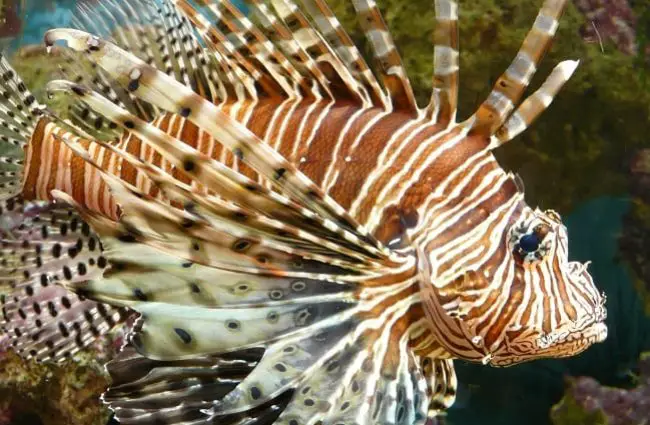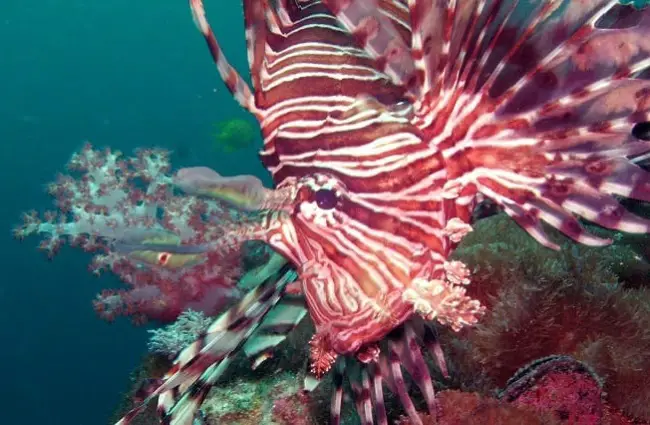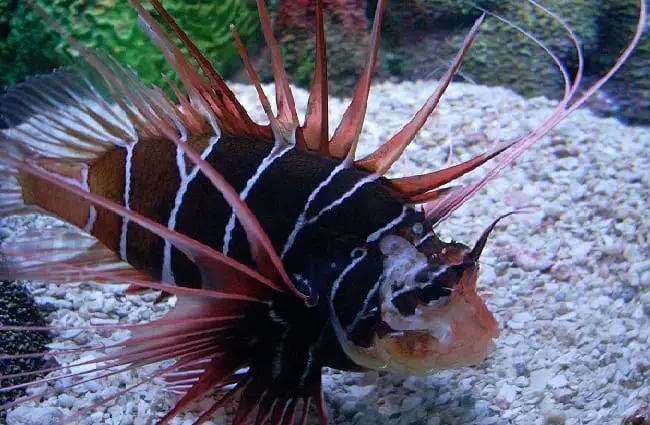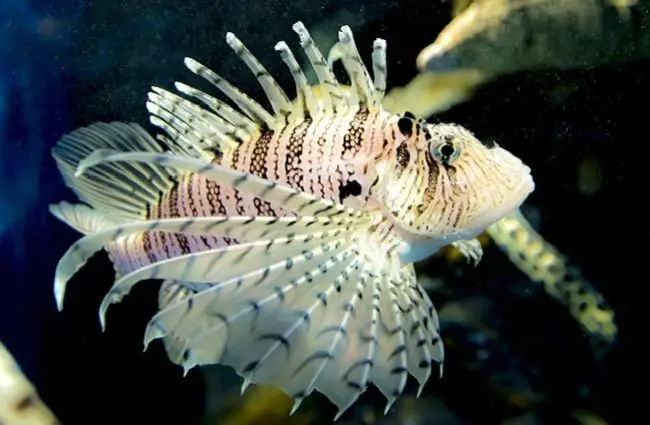The Lionfish: A Symphony of Spines and a Tale of Two Worlds
Beneath the ocean’s surface, a creature of striking beauty and formidable defense glides with an almost ethereal grace. The lionfish, with its flamboyant fins and bold stripes, is a true marvel of marine life. Yet, this captivating fish holds a complex narrative, one that spans its ancient origins in the Indo-Pacific to its more recent, controversial role as an invasive species in the Atlantic. This article delves into the intricate world of the lionfish, exploring its biology, behavior, ecological impact, and its multifaceted interactions with both marine ecosystems and human society.

Anatomy of an Ocean Icon: Appearance and Basic Biology
Lionfish are instantly recognizable members of the scorpionfish family (Scorpaenidae), renowned for their dramatic appearance. Their bodies are adorned with an intricate pattern of reddish-brown, white, and black stripes, a striking camouflage against the backdrop of coral reefs. What truly sets them apart are their elongated, venomous dorsal, anal, and pelvic fin spines, which fan out like a lion’s mane, giving them their regal name. These spines are not just for show; they are a potent defense mechanism.
Typically, lionfish range from 6 to 18 inches (15 to 45 cm) in length, though some individuals can grow larger. Their pectoral fins are exceptionally large and wing-like, often translucent, and used for slow, deliberate movements rather than rapid swimming. This allows them to stalk prey with stealth and precision. They possess a relatively large mouth, capable of engulfing surprisingly large prey items.

Native Realm: Where Lionfish Naturally Thrive
The natural habitat of lionfish encompasses the vast expanse of the Indo-Pacific region. This includes the warm tropical and subtropical waters from western Australia and Malaysia, throughout Southeast Asia, to French Polynesia, and north to southern Japan and South Korea. Within this expansive range, lionfish are typically found in a variety of marine environments, demonstrating remarkable adaptability.
- Coral Reefs: Their preferred domain, offering abundant food and shelter among the intricate coral structures.
- Rocky Outcrops: Providing similar refuge and hunting grounds to reefs.
- Lagoons and Estuaries: Some species can tolerate brackish water, venturing into these transitional zones.
- Mangrove Forests: Offering protection and nursery areas for juvenile fish.
- Seagrass Beds: Used as hunting grounds for smaller prey.
- Wrecks and Artificial Reefs: Providing complex structures for shelter and ambush.
Lionfish are generally benthic, meaning they live on or near the seabed, and can be found at depths ranging from just a few feet to over 1,000 feet (300 meters), though they are most commonly observed in shallower waters accessible to divers.

The Opportunistic Hunter: Lionfish Diet and Feeding Strategies
Lionfish are voracious and opportunistic carnivores. Their diet primarily consists of small fish and crustaceans, making them apex predators in many parts of their native range. They employ a unique hunting strategy, using their large pectoral fins to herd prey into a corner or against a substrate before rapidly engulfing them with their large mouths. This method is highly effective and allows them to consume a wide variety of prey species.
- Small Fish: Including juvenile snapper, grouper, parrotfish, damselfish, and many other reef fish.
- Crustaceans: Such as shrimp, crabs, and other invertebrates.
Their ability to consume a diverse diet, coupled with their efficient hunting techniques, contributes significantly to their success, both in their native and invasive ranges.

The Invasive Enigma: Spread and Ecological Impact
While a natural part of the Indo-Pacific ecosystem, lionfish have become a significant ecological threat in the Western Atlantic, Caribbean Sea, and Gulf of Mexico. Their introduction is largely attributed to the aquarium trade, with individuals likely released by pet owners into these non-native waters. Lacking natural predators in these new environments, lionfish populations have exploded, leading to devastating consequences for native marine life.
The impact of invasive lionfish is profound:
- Predation on Native Species: Lionfish consume vast quantities of native fish and crustaceans, including ecologically important herbivores (like parrotfish, which keep algae in check) and juveniles of commercially important species (like snapper and grouper).
- Competition with Native Predators: They outcompete native predators for food and habitat, further stressing already vulnerable ecosystems.
- Disruption of Food Webs: By removing key species, lionfish can alter the delicate balance of marine food webs, leading to cascading effects throughout the ecosystem.
- Reduced Biodiversity: The unchecked predation by lionfish can lead to significant declines in native fish populations, reducing overall biodiversity on reefs.
This invasive spread highlights the critical importance of responsible pet ownership and the potential for human actions to dramatically alter natural environments.

Life’s Cycle: Mating and Reproduction
Lionfish exhibit a remarkable reproductive capacity, a key factor in their invasive success. Mating typically occurs at dusk, with males performing elaborate courtship displays to attract females. During spawning, a male and female ascend in the water column, releasing a buoyant, gelatinous egg mass into the water. This egg mass, which can contain tens of thousands of eggs, drifts with the currents, a strategy known as pelagic spawning.
- High Fecundity: A single female can spawn every few days, releasing up to 2 million eggs per year.
- Rapid Maturation: Lionfish reach sexual maturity relatively quickly, often within a year.
- Larval Dispersal: The pelagic egg masses and larvae can drift for weeks, allowing for wide dispersal by ocean currents, facilitating their rapid spread across new territories.
This combination of high reproductive output, rapid maturation, and effective dispersal mechanisms makes lionfish incredibly efficient colonizers.

Venom: A Potent Defense
The lionfish’s most striking feature, its elaborate spines, are not merely decorative. They house a potent venom, a crucial defense against predators. Each spine contains a groove through which venom is delivered upon puncture. While not typically fatal to humans, a lionfish sting is intensely painful and can cause a range of symptoms:
- Immediate, excruciating pain: Often described as throbbing or burning.
- Swelling and redness: At the site of the sting.
- Nausea and vomiting: In more severe cases.
- Dizziness and sweating: Systemic reactions can occur.
- Muscle weakness and temporary paralysis: Though rare, these can be serious.
The venom is protein-based and thermolabile, meaning it degrades with heat. First aid for a lionfish sting involves immersing the affected area in hot water (as hot as tolerable, typically 110-115°F or 43-46°C) for 30-90 minutes to denature the venom. Medical attention should be sought to ensure no spine fragments remain and to manage pain and potential secondary infections. For those encountering lionfish in the wild, observation from a safe distance is paramount; never attempt to touch or handle them without proper training and protective gear.

Lionfish in the Wild: Finding and Observing
For the animal lover or aspiring zoologist hoping to encounter a lionfish in its natural habitat, understanding its preferred environments is key. In their native Indo-Pacific range, they are a common sight on healthy coral reefs. In the Western Atlantic, Caribbean, and Gulf of Mexico, they are unfortunately ubiquitous.
- Where to Look:
- Reefs: Both natural and artificial, providing complex structures for shelter.
- Wrecks: Sunken ships and other debris offer excellent habitat.
- Under Ledges and in Caves: They often hide in crevices during the day.
- Mangrove Roots and Seagrass Beds: Especially for juveniles.
- How to Spot Them:
- Lionfish are often solitary, though groups can be seen during spawning.
- They move slowly and deliberately, often hovering motionless.
- Look for their distinctive striped pattern and fanned fins.
- They are most active at dawn and dusk when hunting.
- What to Do if Encountered:
- Observe from a Distance: Admire their beauty but maintain a safe distance.
- Do NOT Touch: Their spines are venomous.
- Report Sightings (in invasive range): Local conservation groups or fisheries departments often have reporting programs to track their spread.
- Participate in Culling Efforts (in invasive range): If trained and equipped, participating in organized lionfish culling events can help manage populations.
Caring for Lionfish in Captivity: A Zookeeper’s Guide
Lionfish are popular aquarium inhabitants due to their striking appearance, but their care requires specific knowledge and precautions. For zookeepers or experienced aquarists, maintaining a healthy lionfish involves several key considerations:
- Tank Requirements:
- Size: A minimum of 75-100 gallons for a single adult, larger for multiple or larger species.
- Aquascaping: Provide ample rockwork, caves, and overhangs for shelter and hiding spots.
- Water Parameters: Stable tropical marine conditions are essential (temperature 72-78°F, salinity 1.020-1.025, pH 8.1-8.4). Excellent filtration is crucial due to their carnivorous diet.
- Diet:
- Carnivorous: Feed a varied diet of meaty foods such as silversides, krill, shrimp, and squid.
- Feeding Frequency: Juveniles may need daily feeding, adults 2-3 times per week.
- Avoid Live Feeder Fish: While they will eat them, live feeders often carry diseases and lack nutritional value. Train them to accept frozen foods.
- Tank Mates:
- Predatory Nature: Lionfish will eat any fish small enough to fit in their mouths.
- Compatibility: Choose tank mates that are too large to be considered prey and are not aggressive towards the lionfish. Examples include larger groupers, snappers, or moray eels.
- Handling and Safety:
- Extreme Caution: Always use thick gloves and a net or container to move lionfish.
- Venom Awareness: Be thoroughly familiar with first aid for stings and have a plan in place for emergencies.
- Avoid Stress: Minimize handling and sudden movements that could startle the fish.
- Enrichment:
- While not typically known for complex behaviors, providing varied feeding methods (e.g., target feeding with tongs) and a stimulating environment can enhance their well-being.

An Evolutionary Journey: Tracing the Lionfish Lineage
The lionfish belongs to the family Scorpaenidae, commonly known as scorpionfish, a diverse group of venomous marine fish. Their evolutionary history is rooted in the ancient oceans, with adaptations that have allowed them to thrive as ambush predators in complex reef environments. The distinctive venomous spines are a key evolutionary innovation, providing a powerful deterrent against predators. Over millennia, lionfish developed their characteristic camouflage and hunting strategies, perfecting their role within the Indo-Pacific ecosystem. Their success in colonizing new territories, however, is a testament to their robust genetics and adaptability, allowing them to exploit new resources in environments where their natural checks and balances are absent.
Ecological Role and Interactions: A Tale of Two Ecosystems
The ecological role of the lionfish differs dramatically between its native Indo-Pacific range and its invasive Atlantic/Caribbean range.
- In Native Indo-Pacific Ecosystems:
- Natural Predator: Lionfish are part of the natural food web, preying on smaller fish and invertebrates.
- Prey Item: In their native waters, they are preyed upon by larger predators such as sharks, groupers, moray eels, and other piscivorous fish, which helps keep their populations in check.
- Ecosystem Balance: They contribute to the natural balance of reef ecosystems, helping to regulate populations of their prey.
- In Invasive Atlantic/Caribbean Ecosystems:
- Apex Predator with No Checks: Lacking natural predators, lionfish have become an unchecked apex predator, consuming vast quantities of native species.
- Competition: They outcompete native predators like snapper and grouper for food and habitat, further stressing these populations.
- Habitat Degradation: By reducing populations of herbivorous fish (e.g., parrotfish), lionfish indirectly contribute to increased algal growth, which can smother corals and degrade reef health.
- Biodiversity Loss: Their intense predation leads to significant declines in native fish populations, threatening local biodiversity and the health of entire reef systems.
Lionfish and Human Culture: From Aquariums to Cuisine
Lionfish interact with human culture in several fascinating ways:
- Aquarium Trade: Their stunning appearance made them highly sought after in the ornamental fish trade, which unfortunately led to their introduction into non-native waters.
- Conservation Efforts: In invasive regions, lionfish have become a focal point for conservation efforts. This includes:
- Culling Derbies: Organized events where divers hunt and remove lionfish to reduce their numbers.
- Public Awareness Campaigns: Educating the public about the threat of invasive species.
- Research: Scientists are actively studying lionfish biology and control methods.
- Culinary Interest: To combat the invasive problem, efforts are being made to promote lionfish as a food source. Their white, flaky meat is delicious, and consuming them helps reduce their populations. “Eat ’em to beat ’em” has become a popular slogan in affected regions.
- Art and Photography: Their unique beauty makes them a popular subject for underwater photographers and artists.
A Huge List of Interesting Facts About Lionfish
The lionfish is full of surprises and intriguing details:
- Master of Camouflage: Despite their flamboyant appearance, their stripes and frilly fins help them blend into the complex patterns of coral reefs.
- Vacuum Cleaners of the Reef: They can consume prey up to half their own body size in a single gulp.
- No Known Natural Predators (in invasive range): In the Atlantic, native predators have not learned to recognize lionfish as prey, largely due to their venomous spines.
- Rapid Spread: Lionfish colonized the entire Caribbean basin in less than a decade after their initial introduction.
- Nocturnal Hunters: While active during the day, they are most effective hunters at dawn and dusk.
- “Freeze” Response: When threatened, lionfish often turn their venomous spines towards the perceived threat and remain motionless, daring predators to approach.
- Long Lifespan: In optimal conditions, lionfish can live for over 10 years.
- Venomous, Not Poisonous: The venom is delivered via injection (sting), not through consumption (poison). Lionfish meat is safe to eat once the spines are removed.
- Unique Fin Structure: Their large, fan-like pectoral fins are used for slow, precise maneuvering, not for fast swimming.
- Sound Producers: Lionfish have been observed producing grunting sounds, particularly during courtship.
Conclusion: A Call to Understanding and Action
The lionfish stands as a testament to the incredible diversity and adaptability of marine life. From its stunning appearance and sophisticated hunting techniques to its potent venom and prolific reproduction, it is a creature of immense biological interest. However, its journey from a native reef dweller to an invasive menace in new oceans serves as a powerful reminder of humanity’s impact on global ecosystems. Understanding the lionfish, in all its complexity, is not just an academic exercise; it is a crucial step towards effective conservation, responsible stewardship, and preserving the delicate balance of our planet’s invaluable marine environments.

![Red Angus Closeup of a beautiful Red Angus cowPhoto by: U.S. Department of Agriculture [pubic domain]https://creativecommons.org/licenses/by/2.0/](https://animals.net/wp-content/uploads/2020/03/Red-Angus-4-238x178.jpg)




![Red Angus Closeup of a beautiful Red Angus cowPhoto by: U.S. Department of Agriculture [pubic domain]https://creativecommons.org/licenses/by/2.0/](https://animals.net/wp-content/uploads/2020/03/Red-Angus-4-100x75.jpg)

